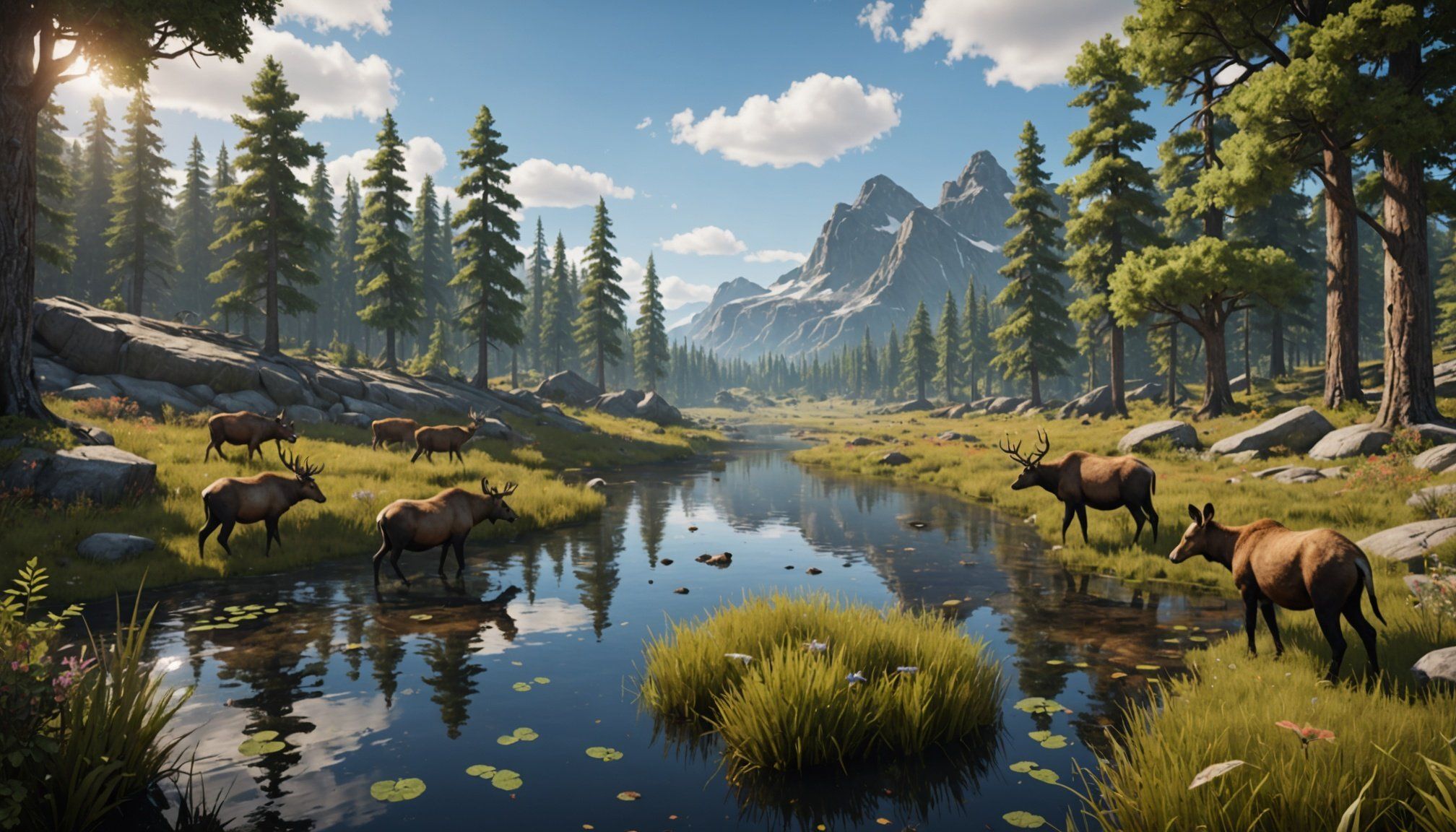Understanding Immersive Ecosystems in Gaming
Immerse yourself in the engaging world of immersive ecosystems. This innovation in gaming focuses on creating highly interactive environments where players interact with diverse flora and fauna. The goal is to simulate the complex relationships found in real-world ecosystems.
Real-time data integration has become crucial in enhancing wildlife simulations. By incorporating live data streams, game developers can reflect actual changes in environments, seasons, and animal behaviours. This creates a dynamic and ever-changing world that keeps players engaged and intrigued.
This might interest you : Endless Horizons: How Procedural Generation Shapes Survival Game Worlds
Gaming innovation now prioritises realism and authenticity, significantly impacting player experiences. Achieving high realism involves leveraging advancements in graphics and sound, along with integrating complex behavioural algorithms for wildlife. Such elements build emotional connections, allowing players to feel more invested in their in-game experiences.
Immersive ecosystems foster unique opportunities for storytelling. They make room for unexpected challenges or delightful surprises that mirror actual wildlife interactions. The experience becomes more enriching as players navigate environments that are not just backgrounds but living, breathing worlds.
Have you seen this : Revolutionizing RPG Character Expressions: Harnessing Machine Learning for Developers
As immersive ecosystems evolve, they are set to redefine how we perceive interaction in gaming, placing a premium on authenticity and setting a new standard for how games captivate and retain their audience. This innovation promises a future where gaming meets reality in the most spectacular way.
Live Biome Data Integration
Integrating live biome data into games is revolutionising how developers create immersive environments. This real-time integration means that games can dynamically adapt to current environmental changes, greatly enhancing data-driven simulations. Through technologies like IoT sensors and satellite data, developers acquire up-to-date information on weather, vegetation growth, and even animal migrations. This integration fosters more authentic and interactive in-game experiences.
Overview of Live Biome Data
Biome data encompasses various environmental indicators such as climate patterns, terrain types, and biological diversity. In the context of gaming, this data is used to recreate ecosystems that respond realistically to external changes. For instance, a sudden rainstorm in the real world can trigger similar weather in the game, impacting gameplay and player strategy.
Technologies enabling Data Integration
Technological advancements are pivotal for real-time data collection and its integration into games. The use of drones, satellite imagery, and IoT networks provides detailed environmental data that games can use to offer more nuanced experiences. AI and machine learning algorithms process this data, allowing ecosystems to evolve concurrently with real-world changes, thus enhancing player engagement.
Case Studies in Game Development
Wildlife simulation titles serve as a testament to how games have leveraged live biome data for immersive ecosystems and innovative gameplay. These games exhibit the creative application of real-world data, producing lifelike environments that captivate players.
Notable Games Using Live Biome Data
A handful of games have pioneered this integration. Titles such as “Red Dead Redemption 2” and “Horizon Zero Dawn” have revolutionised the depiction of natural environments with stunning realism. By incorporating data-driven simulations, these games ensure dynamic weather, authentic animal behaviour, and seasonal changes that mirror real-life conditions.
Success Metrics and Player Responses
Success metrics often focus on player engagement and satisfaction. Users report feeling more connected to games that offer rich, immersive gameplay. Feedback indicates a high appreciation for environments that respond intuitively to player actions, enhancing the gaming experience.
Lessons Learned from Development
The fusion of biome data and wildlife simulations offers insights into crafting emotionally engaging experiences. Developers have found that sensory details—sounds of rustling leaves or a distant storm—intensify player immersion. Future projects can draw from these successes, with an emphasis on evolving game mechanics and storytelling techniques that utilise innovative game examples.
Future Trends in Wildlife Simulations
The landscape of wildlife simulations in gaming is rapidly evolving. Emerging technologies like AI and machine learning are at the forefront of these advancements, and are poised to redefine how games incorporate realistic environments. By using sophisticated algorithms, developers can create ecosystems that adapt fluidly to player interactions, offering unprecedented realism.
Predictions for the future suggest a heightened integration of biome data within gaming. Future innovations focus on perfecting the simulation of natural behaviours, making virtual fauna behave with striking authenticity. The integration process is expected to benefit from advancements in AI, leading to ecosystems that mimic the complexities of real-world interactions with impressive precision.
These developments are likely to significantly influence gaming industry trends, particularly within open-world and strategy genres. As player expectations for immersive experiences grow, the demand for more authentic, data-driven simulations will increase. Players are expected to demand deeper, more natural interactions within their virtual environments, pushing the industry to innovate further.
Potential impacts are vast, ranging from more engaging storytelling opportunities to gameplay dynamics that evolve based on real-time environmental feedback. These trends will likely challenge traditional gaming mechanics, forging a path where digital innovation closely imitates reality.
Enhancing Player Experience through Realism
Realistic environments in gaming revolutionise how players perceive and interact with virtual worlds. The impact of realistic ecosystems is profound, as they significantly boost player engagement. When players encounter flora and fauna that behave authentically, their level of immersion skyrockets. Accurate depictions foster a sense of wonder and awe, intensifying the gaming experience.
Natural interactions in these environments lead to deep emotional connections. Players often bond with the game’s world, feeling their actions contribute to a living, breathing ecosystem. This emotional resonance heightens their investment, making gameplay more captivating.
Feedback has shown that players express high satisfaction when games achieve a realistic simulation. Authentic soundscapes, weather patterns, and animal behaviours create a believable atmosphere, enhancing the overall player experience. Players report feeling part of a larger story as they interact with these detailed landscapes.
Moreover, games focusing on realism often receive praise for their immersive gameplay. As players become engrossed in these worlds, they not only enjoy playing but also appreciate the intricate designs and the authenticity brought by realistic environments. The demand for such immersive experiences continues to rise, encouraging developers to push boundaries.











